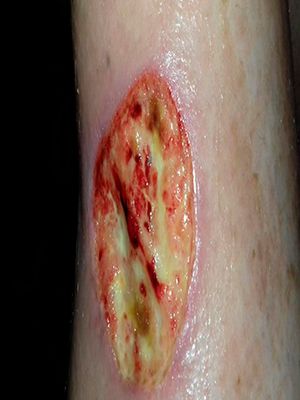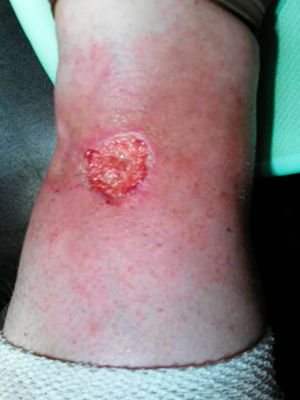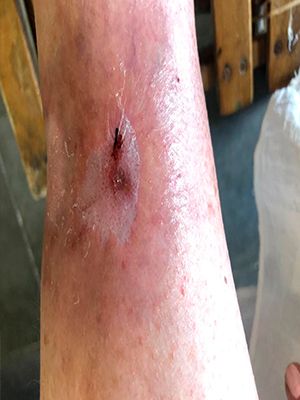- Usage
- Usage Cases
- Trophic ulcer of the leg, woman, 48 years old
Case №48
Trophic ulcer of the leg
Time period for the presence of a wound : 3 months
Application of Mirragen: 7.03.19
USA
-
Patient:
Woman
-
Age:
48 years old
-
Diagnosis:
Trophic ulcer of the leg
Diagnostics and treatment of trophic ulcers.
The popular opinion is that a trophic ulcer goes away on its own without any treatment. On the one hand, this is not devoid of truth. On the other hand, it requires compliance with certain conditions: strict bed rest, treatment of wounds with antiseptics, wearing compression hosiery. But this does not exclude the possibility that ulcers will return with renewed vigor, because, we repeat, this is not the disease itself, but a symptom. Hence, the correct treatment should correct the original cause of the lack of nutrition in the tissues. Each patient needs his own treatment program, drawn up by a phlebologist.
But let's discuss the symptomatic treatment of the ulcer itself.
• Anesthesia in the form of tablets, injections, creams or gels: parmidin, ibuprofen, emla.
• Taking antibiotics.
• Antiseptics: levomethicin or miramistin.
• Antimycotics: voriconazole or fluconazole.
• Antiplatelet agents: acetylsalicylic acid or heparin.
• For healing: sulfargin and actovegin.
Trophic ulcers are also treated in more radical ways - surgically, and with the help of a laser, and sclerotherapy. Only serious treatment can reduce the risk of relapse!
The most effective methods of treatment are considered to be the use of a laser, which removes stagnation of blood in the veins and accelerates the healing of ulcers, ultrasound cavitation, UV irradiation, hyperbaric oxygenation, magnetotherapy, as well as the use of a sclerosant drug, but the most effective in modern conditions is the use of the Mirragen product.
Mirragen is used to heal skin and soft tissue injuries and ulcers caused by the following:
Infected surgical wounds.
- Diabetic foot
- Healing of leg ulcers with varicose veins.
- Treatment of pressure sores.
- Regeneration of fresh wounds and surgical incisions.
- Healing of burns of I and II degrees.
Mirragen Terms of Use
It is necessary to apply Mirragen in compliance with all the rules and requirements of asepsis and antiseptics under sterile conditions. For effective action, the primary surgical treatment of the wound surface is preliminarily carried out, that is, the necrotic tissues are truncated, excess moisture and purulent contents are removed.
Mirragen is available as a matrix. To apply to the wound, it is necessary to cut a piece of the required size and completely cover the wound surface with it. During the integration of Mirragen into the open tissue of the wound, some visual changes are observed:Mucus production;
Uniform deepening of the matrix into the thickness of soft tissues
Formed tissue granulation.
The dressing with Mirragen is applied after 3-7 days. Some redness may occur during the healing process with Mirragen Matrix. This is normal. Sometimes discoloration of the matrix occurs on contact with the wound surface. Dry edges of the skin may look too dry and cracked.
Removing Mirragen from a wound
Since the structure of the agent is completely dissolved in the content of the wound channel, there is practically nothing to remove. If necessary, after the completion of the treatment course, the wound is washed, all remnants of Mirragen parts or fibers and gauze dressing are washed off.
After the ulcer has healed, you will have to try to prevent recurrence! Adjust your lifestyle by adding moderate activity, visit an orthopedic salon, take a course of physiotherapy - maintain a healthy immune system and watch your health!
General conclusions
At the first signs of trophic ulcers, we recommend that you contact a trusted specialist in order to prevent complications and progression of symptoms. Remember that the consequences of improper treatment can threaten not only health, but also life.Consultations on the use of Mirragen product you can get by phone +38 (067) 670-67-84
Cooperate With Us
or via contact phones or email
-
Conveniently
By contacting only one supplier, our customers receive a wide range of products in the shortest possible time.
-
Simple
Our customers are only required to form an order for the supply of products, we will take care of all further tasks
-
Profitable
We save our customers money on import
and delivery taxes



